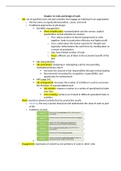Summary
Summary Tort Oxford PQ Summaries or Guide All Tort Topics (apart from defamation)
- Module
- Tort Law
- Institution
- Oxford University (OX)
This guide will be sufficient to get a high 2.1/1st in finals if you do only problem questions as you will be able to answer all PQs apart from the defamation one. It also includes summaries on the newly added topic of Intentional personal mistreatment, which most summaries are missing. If you lea...
[Show more]








